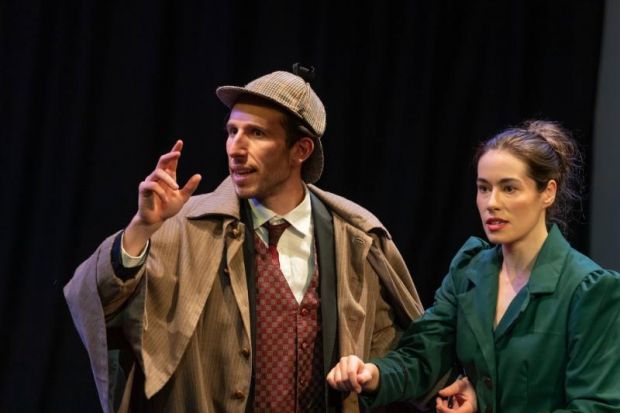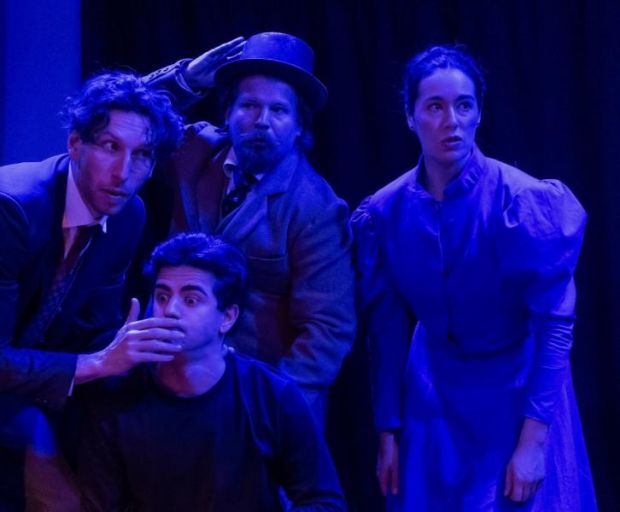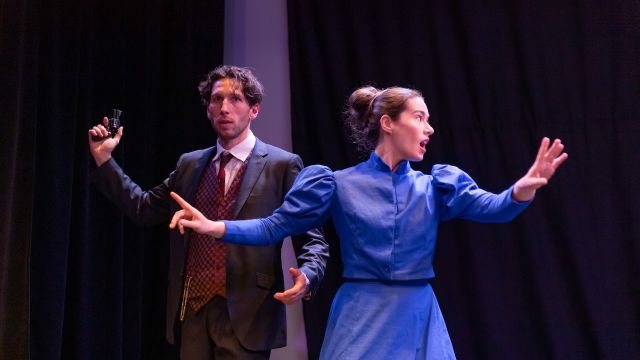Moriarty: A New Sherlock Holmes Adventure
Ken Ludwig’s Moriarty is a whip-smart, laugh-out-loud addition to the Sherlock Holmes canon, blending a classic mystery with the playwright’s trademark wit and fast-paced theatricality. Following the critical success of Baskerville, Ludwig once again brings Holmes and Watson into a whirlwind case—this time revolving around stolen letters from a Bohemian king, international espionage, and a race to thwart the calculating Professor Moriarty. Joined by the ever-intriguing Irene Adler, the duo hurtles from London to continental Europe, encountering spies, henchmen, and royal entanglements—all performed by a small, agile ensemble playing dozens of roles.

Director Gregory George embraces Ludwig’s humour while adding bold, imaginative touches. Most notable is the use of large-scale puppetry to represent Moriarty’s control over his criminal network—a visual metaphor for his manipulations. Though the decision may divide purists, it adds a creative, playful energy that suits Ludwig’s style.
Peter David Allison’s John Watson serves as both narrator and partner-in-detection, delivering the story with urgency, conviction, and beautifully articulated authenticity. His comic timing is impeccable, his presence commanding without overshadowing Holmes, and his seamless movement between narration and action keeps the momentum at a cracking pace.
As Sherlock Holmes, Joshua McGowan is a powerful, charismatic presence—arrogant, razor-sharp, and entirely believable as the world’s greatest detective. While some lines on opening night were delivered a touch too quickly (perhaps the rush of first performance energy), his portrayal captured Holmes’ brilliance and magnetism.
Jessica Joseph-McDermott’s Irene Adler is striking, sassy, and captivating. Her verbal sparring with Holmes crackles, their attraction handled with just enough restraint to intrigue the audience. The chemistry between Joseph-McDermott and McGowan was both authentic and tantalising, made all the more effective by George’s sensitive direction.
As the titular villain, Peter Gizariotis delivers an unhinged, menacing Moriarty whose murderous intent feels chillingly real—worthy of Holmes’ ultimate showdown.

The supporting quartet of actors bring Ludwig’s bustling world to life with remarkable range and precision.
● Dimitri Poulos, covering an amazing six roles, shines especially as Toby (woof), stealing scenes with comic flair.
● Isla Harris charms with her cockney accent and naïve warmth, ensuring even her smallest roles are memorable.
● Susan Jordan gives an excellent Mrs Hudson and demonstrates superb puppetry and voice work across her multiple parts.
● Matthew Dell is a standout, distinguishing each of his four characters—especially Mycroft Holmes and Lestrade—without a hint of overlap.
The climax at the waterfall—Holmes, Adler, and Moriarty locked in a fight for their lives—is conceptually brilliant and visually mesmeric. This is a memorable scene using clever design elements. The aftermath back at 221B Baker St is accompanied by a delightful underscore which lends subtle emotion and poignancy to Watson and Holmes’ reflections. The final moments are quietly affecting: a bittersweet image of Holmes dreaming of what might have been.

George’s staging adapts nimbly to technical challenges. Originally aiming for projected backgrounds and video sequences, technical difficulties meant that he instead had to employ moving scenic panels with varied backdrops. While some transitions are still a little clunky and the movement of screens can be distracting mid-dialogue, they provide essential visual context for the rapid scene changes. Clever lighting and sound design by Michael Schell add layers of atmosphere to the otherwise minimal, portable set.
What truly elevates this production is the cohesiveness between the talented cast and the hardworking backstage crew. The pace feels tightly interwoven, with actors feeding off each other’s energy and responding instinctively to shifts in pace and tone. Scene changes—though occasionally challenged by the logistics of moving the screens—are executed with a shared determination to keep the story flowing. The crew’s timing in lighting, sound, and set movement ensures that the actors can remain fully immersed in their characters, never breaking the rhythm of the performance. This synergy between onstage and offstage artistry gives the production its pace and urgency, allowing Ludwig’s humour and suspense to shine without distraction.

This Moriarty is an engaging, inventive interpretation of Ludwig’s very funny script. The combination of high-energy ensemble work, clever risk-taking, and striking visual choices makes for an evening that both honours the spirit of Conan Doyle’s creations and pushes the boundaries of how their adventures can be staged.
RizzieReviews
Subscribe to our E-Newsletter, buy our latest print edition or find a Performing Arts book at Book Nook.

